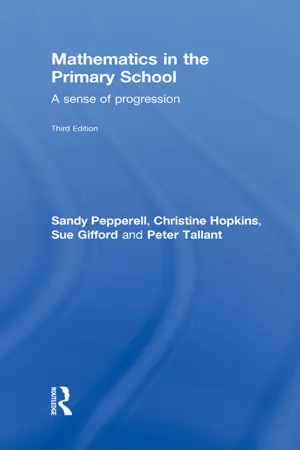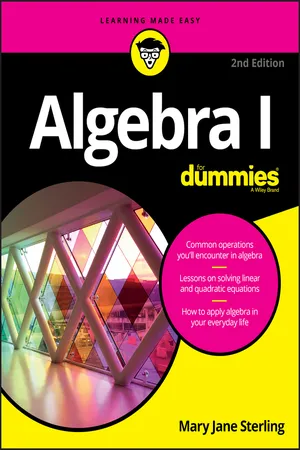Mathematics
Finding the Area
Finding the area involves calculating the amount of space enclosed by a two-dimensional shape. The area of a shape is typically measured in square units, such as square meters or square inches. The process for finding the area varies depending on the shape, but generally involves multiplying the dimensions of the shape.
Written by Perlego with AI-assistance
Related key terms
4 Key excerpts on "Finding the Area"
- eBook - ePub
Mathematics in the Primary School
A Sense of Progression
- Sandy Pepperell, Christine Hopkins, Sue Gifford, Peter Tallant(Authors)
- 2014(Publication Date)
- Routledge(Publisher)
So area is an important building block in mathematical and scientific development. Whilst accepting that it should be taught meaningfully, it is not always necessary to take a lot of time and trouble concocting practical situations which pretend to contain area. Materials such as transparent grids and geoboards are useful for posing problems involving area. On geoboards ask children to make shapes with a particular area, for example, eight squares. Ask, ‘Look at the shapes. Will the perimeter remain the same?’ (Geoboards have nails at the points of a square grid, elastic bands are stretched between the nails to make shapes.)A common misconception is to overgeneralise the correct result that the area of a rectangle is obtained by multiplying the length by the breadth by applying this to all areas regardless of the shape in question. This can be avoided by ensuring that children find the area of many different kinds of shape, including irregular shapes such as leaves, and also insisting that children are precise in their use of mathematical statements, for example, ‘The area of a rectangle is length × breadth’.PerimeterPerimeter, an aspect of measuring length, is often confused with area. Dickson et al. (1984) suggest that this might be due to early formalisation through the introduction of formulae before children have had sufficient experience of exploring the shapes practically. They suggest activities to show that area can be varied while perimeter stays constant, and vice versa. If a shape has all its sides doubled but retains the same angles, its area will be quadrupled.Using squared paper or a geoboard the teacher can ask: ‘How many shapes can you make from 12 squares?’ ‘What are the perimeters of those shapes?’ ‘How many shapes can you make with a perimeter of 12?’ ‘Find the area of each of the shapes. Is it always the same?’The perimeter of a circle is called the circumference. When using trundle wheels, children can be asked to measure the diameter of the wheel and compare this with the circumference. ‘Do all trundle wheels have the same diameter?’ ‘Can you find a cylinder that will roll through 30 centimetres?’ ‘What is the diameter for a 30 centimetre roll?’ By experiment, children can find that the circumference is roughly three times the diameter. The actual ratio is not a rational number (see the Glossary in Section 2.4 - eBook - ePub
- Mary Jane Sterling(Author)
- 2016(Publication Date)
- For Dummies(Publisher)
Picture a floor covered with square tiles. If each tile is 1 foot by 1 foot, counting the number of tiles tells you how large the floor is in square feet. In the real world, most floors aren’t covered with tiles that are a convenient 1-foot square. And most tile floors have partial tiles on the edges and in the corners and around things that are strange shapes. So area formulas, such as the ones in this section, help you do the figuring to determine the area.In the previous section, the perimeter formulas deal with linear measure. Linear measure is just one dimension. It’s from one place to another — there’s no breadth to it. You measure it with a ruler or yardstick or tape measure in one direction. Square measurements are used to measure area. Area takes two measures — one along a side and a second perpendicular (90 degrees) to that side.Laying out rectangles and squares
Rectangles and squares have basically the same area formulas because they both have square corners and the equal lengths on opposite sides. The general procedure here is just to multiply the measure of the length times the measure of the width. The product of two sides that are next to one another is the area.Finding the Area of a rectangle or square
Most rooms in homes and offices are rectangular in shape. Desks and tables and rugs are usually rectangular, also. This makes it easy to fit furniture and other objects in the room.The area of a rectangle is its length times its width, and the area of a square is the square of the measure of any side:- Rectangle: A = l × w
- Square: A = s 2
A garden 85 feet long by 35 feet wide needs some fertilizer. If a bag of fertilizer covers 6 square yards, how much fertilizer do you need?Note that the measures are different. The garden is measured in feet and the fertilizer coverage is in square yards. Determine how many square feet the garden is. Then convert the fertilizer coverage to square feet per bag.area of garden = l × w = 85 × 35 = 2,975 square feetNow, how many square feet are there in a square yard? If a yard is equal to 3 feet, then a square yard is 3 feet by 3 feet, so the area is 32 - eBook - ePub
Knowing and Teaching Elementary Mathematics
Teachers' Understanding of Fundamental Mathematics in China and the United States
- Liping Ma(Author)
- 2020(Publication Date)
- Routledge(Publisher)
4 Exploring New Knowledge: The Relationship Between Perimeter And AreaScenario
Imagine that one of your students comes to class very excited. She tells you that she has figured out a theory that you never told the class. She explains that she has discovered that as the perimeter of a closed figure1 increases, the area also increases. She shows you this picture to prove what she is doing:How would you respond to this student?Students bring up novel ideas and claims in their mathematics classes. Sometimes teachers know whether a student’s claim is valid, but sometimes they do not. The perimeter and area of a figure are two different measures. The perimeter is a measure of the length of the boundary of a figure (in the case of a rectangle, the sum of the lengths of the sides of the figure), while the area is a measure of the size of the figure. Because the calculations of both measures are related to the sides of a figure, the student claimed that they were correlated.The immediate reactions of the U.S. and Chinese teachers to this claim were similar. For most of the teachers in this study, the student’s claim was a “new theory” that they were hearing for the first time. Similar proportions of U.S. and Chinese teachers accepted the theory immediately. All the teachers knew what the two measures meant and most teachers knew how to calculate them. From this beginning, however, the teachers’ paths diverged. They explored different strategies, reached different results, and responded to the student differently.How the U.S. Teachers Explored the New Idea
Teachers’ Reactions to the Claim
Strategy I: Consulting a Book
While two of the U.S. teachers (9%) simply accepted the student’s theory without doubt, the remainder did not. Among the 21 teachers who suspected the theory was true, five said that they had to consult a book. Four of the five explained that they needed a book because they did not remember how to calculate perimeter and area: - eBook - ePub
Teaching Mathematics in Primary Schools
Principles for effective practice
- Robyn Jorgensen(Author)
- 2020(Publication Date)
- Routledge(Publisher)
Take an A4 sheet of paper and cut it diagonally. Reorganise the shape so that it looks like the second shape here.- Which is bigger in area? Justify your answer.
Teaching IdeaTake an A4 sheet of paper. Cut it into four or so pieces using straight cuts (or use a tangram). Create new shapes. Allow students to predict and explore the amount of area in the new shapes and the new perimeters.- Create a table of results.
- What did you notice?
Teaching strategies
- Grid paper can be a useful tool for implementing formal units of measure. Centimetre-square paper can be used for drawing or tracing shapes and then counting the area. The grid paper can also be copied onto transparencies so that students can overlay it on shapes and count the number of squares. It is useful to begin with whole numbers and build progressively to more complex numbers and shapes (including circles).
- Use large sheets of newspaper to make square metres so that larger areas can be covered.
- Create situations in which students can 'discover' formulae for various shapes, Allowing them to discover a formula will make it more meaningful than if it has been rote learned. Once students have developed a strong conceptual understanding of area, software such as GeoGebra can be used to reinforce their understanding (www.geogebra.org/m/vDxUbcTT ).
- As before, personal referents should be developed for area; for example, a small fingernail might represent 1 cm2 .
- Large areas, such as hectares and large land or sea areas, are difficult to conceptualise. World mapping exercises can be fun and illuminating for students. Compare the area of Australia with that of the United States and the United Kingdom. Students often think that countries they hear a lot about must be big in terms of their areas. It is often very surprising to learn that Australia and Europe are almost the same size; likewise, the United States and Australia are of similar areas. Compare how many times the United Kingdom fits into countries such as New Zealand, Canada, Australia or Kenya. These activities also have application to social studies. Software such as Google Earth provides useful resources for helping children conceptualise large areas.
Learn about this page
Index pages curate the most relevant extracts from our library of academic textbooks. They’ve been created using an in-house natural language model (NLM), each adding context and meaning to key research topics.



